| Article ID | Journal | Published Year | Pages | File Type |
|---|---|---|---|---|
| 301066 | Renewable Energy | 2012 | 10 Pages |
This article describes improved techniques to calculate the wind power resource of an offshore area. The method uses publicly available oceanic, environmental and socio-economic data to identify areas less suitable for development due to physical or technical constraints, safety or other hazards, environmental concerns, or competing uses. Using wind speed data from meteorological buoys, annual energy output is calculated for a representative offshore wind turbine. The average power resource is determined by dividing the total available area by a wind regime and the turbine-specific effective turbine footprint, yielding the maximum number of turbines, and then derating the output to account for wake effects and operational availability.These techniques are applied to quantify the previously undocumented offshore wind resource off the coast of Maryland, a U.S. Atlantic coastal state. We consider only the open-ocean Atlantic and not Maryland’s substantial estuary, the Chesapeake Bay. We find that the wind field is fairly uniform, but exclusions of ocean areas due to competing use may be substantial, reducing the energy resource estimate significantly. Nevertheless, we find that even excluding these areas Maryland’s offshore wind resource could supply an annual average of 14,087 Megawatts (MWa), or 123,400 GWh of energy per year. This is equal to 189% of the state’s annual electricity consumption. Further restricting to only shallower-water foundation technology (monopiles), average power output would still be 70% of electricity demand. We conclude with a discussion of policy options for coastal states.
► Power potential methodology improves upon existing offshore resource assessments. ► Includes bathymetry delineations based on technology advancements. ► Acknowledges previously unaddressed, potential conflict with commercial shipping. ► Presents previously un-quantified offshore wind potential for Maryland. ► Results are presented in terms useful for energy planners and policy makers.
